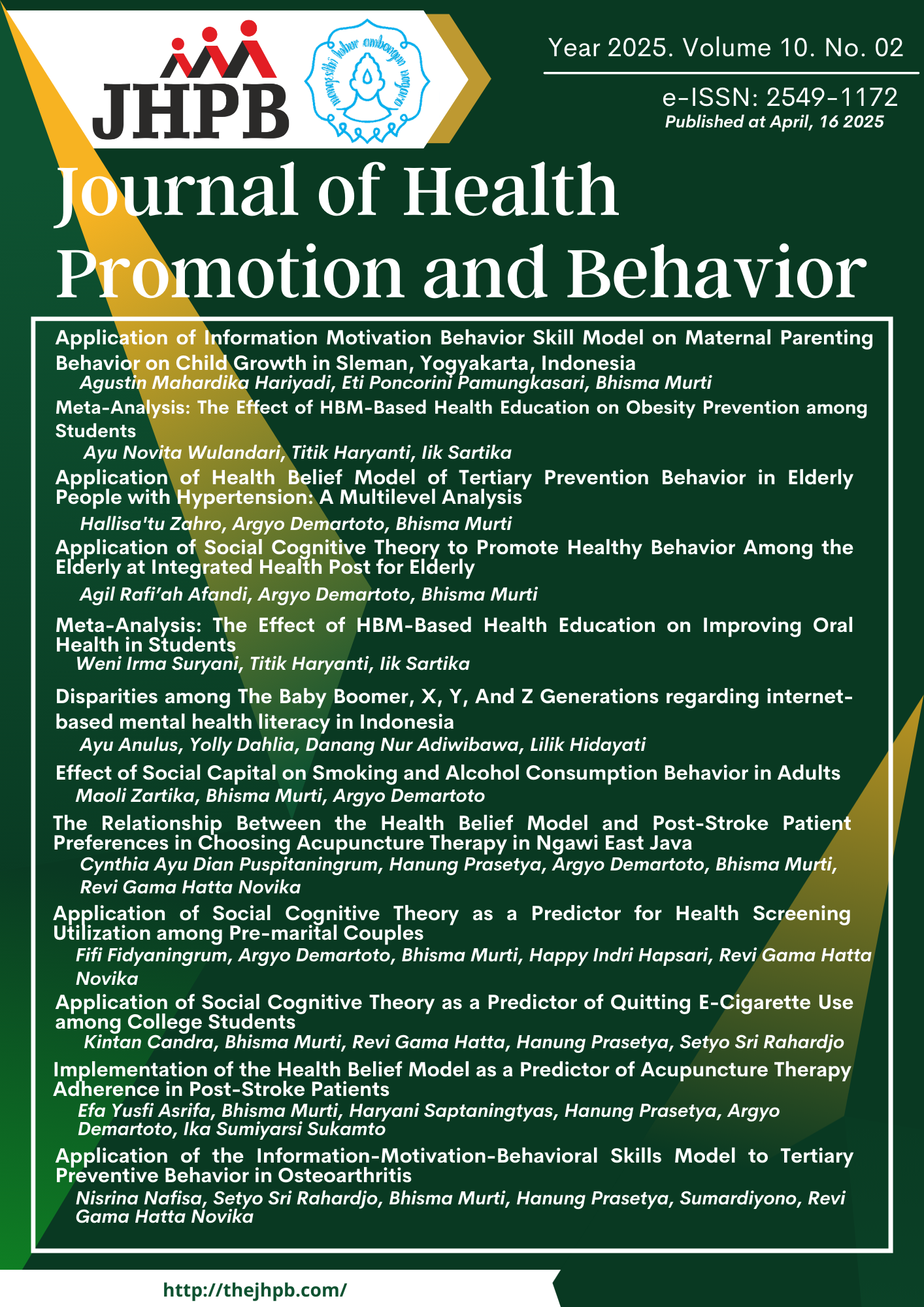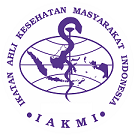Effect of Social Capital on Smoking and Alcohol Consumption Behavior in Adults
DOI:
https://doi.org/10.26911/thejhpb.2025.10.02.07Abstract
Background: Clinical epidemiological studies show that smoking and alcohol are often used together as social activities. Smoking and alcohol consumption are related to the risk of developing non-communicable diseases. According to data from the Indonesian Health Survey (SKI), (2023) the percentage of smokers in Surakarta City is 23.6% and the percentage of alcohol consumption is 1.4%. This study aims to analyze the influence of social capital on smoking behavior and alcohol consumption in adults.
Subjects and Method: The research design used is a cross-sectional study. The population in this study is adults aged 19-59 years in the city of Surakarta. Sampling in the study was carried out by the snowball sampling method, then as many as 200 adults domiciled in the city of Surakarta were obtained. The method used in collecting data for this study is a questionnaire. The analysis used in this study is the Structural Equation Model (SEM) to analyze the influence of social capital elements on smoking behavior and alcohol consumption in adults. The dependent variables are smoking habits and alcohol consumption. The independent variable is social capital including 3 elements, namely structural elements, cognitive elements and relational elements.
Results: Social capital had a negative effect on smoking behavior (b= -0.80; 95% CI= -0.88 to -0.71; p= 0.001), and social capital has a negative effect on alcohol consumption (b= -0.71; 95% CI= -0.80 to -0.63; p= 0.001).
Conclusion: The results of this study show that social capital constructs include structural elements, cognitive elements and relational elements that are high have a lower likelihood of smoking behavior and alcohol consumption in adults.
Keywords:
Social capital, smoking, alcohol consumption, adultsHow to Cite
References
Adnum L, Elliott L, Raeside R, Wadd S, Madoc-Jones I, Donnelly M. (2024). Social capital and alcohol risks among older adults (50 years and over): analysis from the Drink Wise Age Well Survey. Age Soc. 44(3):661–680. doi:10.1017/S0144686X22000393.
Claridge T. (2018). Dimensions of social capital—structural, cognitive, and relational. Soc Cap Res. 1:1–4.
Hasan MZ, Cohen JE, Bishai D, Kennedy CE, Rao KD, Ahuja A, Gupta S. (2020). Social capital and peer influence of tobacco consumption: a cross-sectional study among house-hold heads in rural Uttar Pradesh, India. BMJ Open. 10(6):e037202. doi:10.1136/bmjopen-2020-037202.
Institute for Health Metrics and Evaluation (IHME). (2019). Global burden of di-sease. Inst Health Metr.
Kim JR, Jeong B, Park KS, Kang YS. (2020). Individual-level associations between indicators of social capital and alcohol use disorders iden-tification test scores in communities with high mortality in Korea. J Prev Med Public Health. 53(4):245–253. doi:10.3961/jpmph.19.336.
Kuerbis A. (2020). Substance use among older adults: an update on prevalence, etiology, assessment, and intervention. Gerontology. 66(3):249–258. doi: 10.1159/000504363.
Magson NR, Craven RG, Munns G, Yeung AS. (2016). It is risky business: can social capital reduce risk-taking beha-viours among disadvantaged youth? J Youth Stud. 19(5):569–592. doi:1-0.1080/13676261.2015.1098776.
Moore S, Teixeira A, Stewart S. (2014). Effect of network social capital on the chances of smoking relapse: a two-year follow-up study of urban-dwell-ing adults. Am J Public Health. 104(12):e72–e76. doi:10.2105/AJPH-.2014.302142.
Riskesdas. (2018). Laporan Provinsi Jawa Tengah Riskesdas 2018. Jakarta: Badan Penelitian dan Pengembangan Kesehatan.
Rodgers J, Valuev AV, Hswen Y, Subrama-nian SV (2019). Social capital and physical health: an updated review of the literature for 2007–2018. Soc Sci Med. 236:112360. doi:10.1016/j.socs-cimed.2019.112360.
Seid AK, Hesse M, Bloomfield K. (2016). Make it another for me and my mates: does social capital encourage risky drinking among the Danish general population? Scand J Public Health. 44(3):240–248. doi:10.1177/1403494815619536.
Survei Kesehatan Indonesia (SKI). (2023). Survei Kesehatan Indonesia (SKI) 2023 dalam angka. Badan Kebijakan Pembangunan Kesehatan.
Slagter SN, van Vliet-Ostaptchouk JV, Vonk JM, Boezen HM, et al. (2014). Com-bined effects of smoking and alcohol on metabolic syndrome: the LifeLines cohort study. PLoS One. 9(4):e96406. doi:10.1371/journal.pone.0096406.
Sun Q, Lu N (2024). Community social capital and self-rated health among older adults in urban China: the mo-derating roles of instrumental acti-vities of daily living and smoking. Ageing Soc, 1–18. Doi:10.1017/S0-144686X23000958.
Villalonga E, Almansa J, Shaya F, Kawachi I. (2020). Perceived social capital and binge drinking in older adults: The Health and Retirement Study, US data from 2006–2014. Drug Alcohol Depend, 214: 108099. Doi: https://-doi.org/10.1016/j.drugalcdep.2020.108099.
Wang Z, Fang Y, Zhang X (2024). Impact of Social Capital on Health Behaviors of Middle-Aged and Older Adults in China—An Analysis Based on CHARLS2020 Data. Healthcare, 12(11): 1154. https://doi.org/10.3390-/healthcare12111154.
WHO (2018). Global status report on alcohol and health 2018. Switzerland. World Health Organization.
WHO. (2023). Tobacco. Switzerland. World Health Organization.
Xu P, Jiang J (2020). Individual capital structure and health behaviors among Chinese middle-aged and older adults: A cross-sectional analysis using Bourdieu’s theory of capitals. Int J Environ Res Public Health, 17(20): 7369. Doi: https://doi.org/10-.3390/ijerph17207369.
Xue X, Cheng M. (2017). Social capital and health in China: exploring the media-ting role of lifestyle. BMC Public Health, 17: 1–11. Doi: 10.1186/s12889-017-4883-6
Yang Y, Wang S, Chen L, Luo M, Xue L, Cui D, Mao Z (2020). Socioeconomic sta-tus, social capital, health risk beha-viors, and health-related quality of life among Chinese older adults. Health Qual Life Outcomes, 18: 1–8. Doi: https://doi.org/10.1186/s12955-020-01540-8.
Zahedi H, Sahebihagh MH, Sarbakhsh P, Gholizadeh L (2021). The association between cigarette smoking attitudes and social capital among Iranian health and medical students: a cross-sectional study. BMC Public Health, 21: 1–8.





